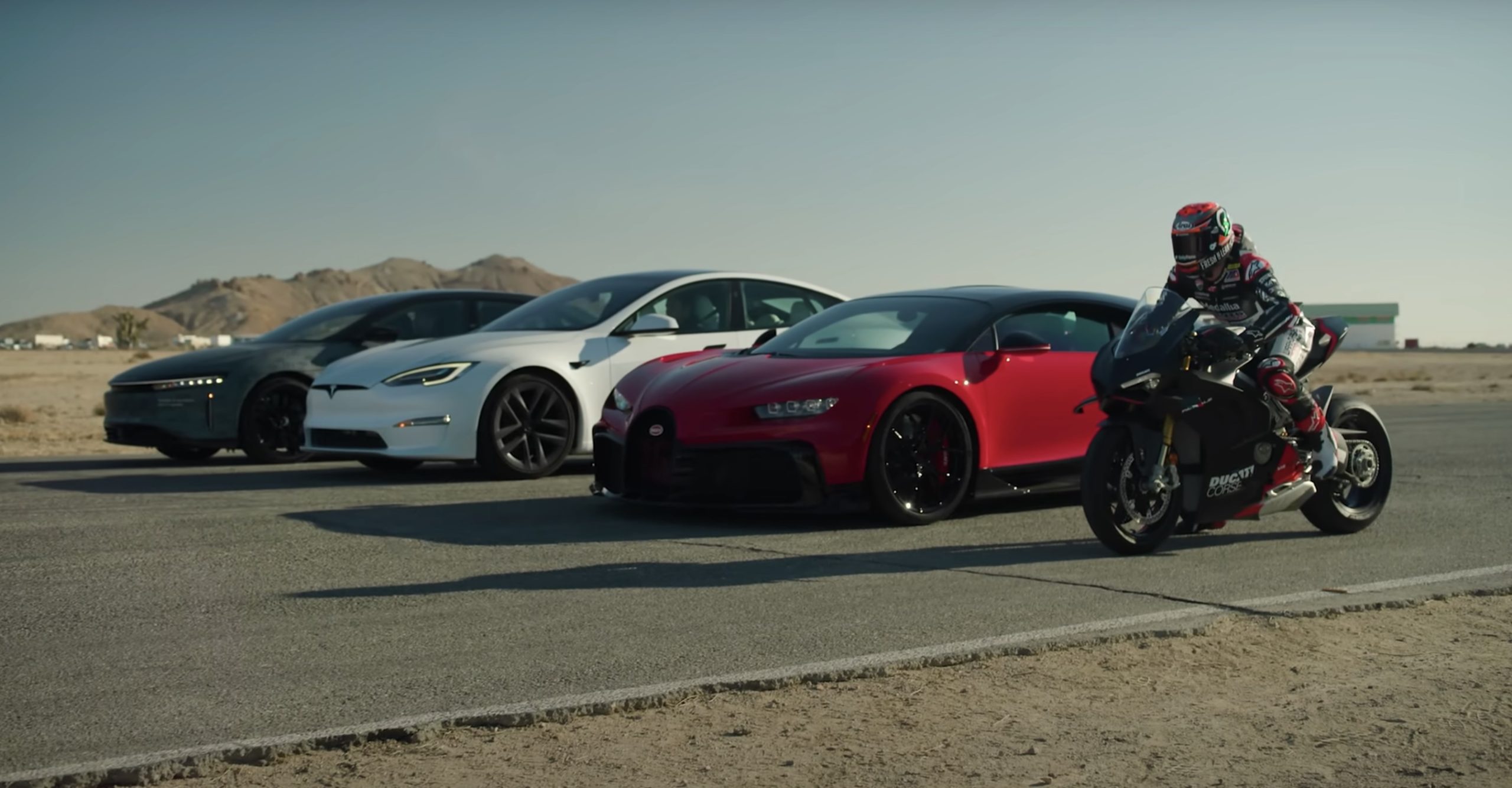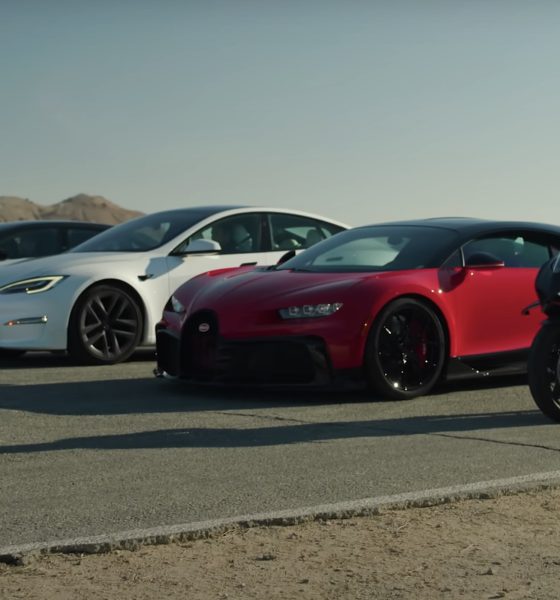

Lifestyle
Tesla Model S Plaid comes in last against Lucid Air Sapphire, Bugatti Chiron Pur Sport in drag race
The stakes in the electric vehicle war have just been raised. Following a drag race against a frighteningly quick all-electric champion and the pinnacle of the internal combustion engine — both in four and two wheels — the Lucid Air Sapphire proved that it has what it takes to be at the top of the drag race summit.
YouTube channel Hagerty gathered some of the world’s fastest vehicles in a recent video. Among the vehicles was the Tesla Model S Plaid, the $136,000 supercar killer that has slain countless performance vehicles on the drag strip, including those that were several times its price. Another was the Bugatti Chiron Pur Sport, a limited edition, $4 million, 1500-horsepower, 8-liter, 16-cylinder, four-turbocharged hypercar.
The Lucid Air Sapphire is — similar to the Model S Plaid — fitted with three electric motors. Its horsepower is listed at over 1,200, which is not that far from the Plaid’s 1,020 horsepower. The Sapphire is notably more expensive than its Tesla counterpart, however, with Lucid’s configurator pricing the car at $250,000 to start.
The Results
Hagerty conducted a couple of drag race tests featuring the Lucid Air Sapphire, one against the Tesla Model S Plaid and Bugatti Chiron Pur Sport, and another against the Ducati Panigale V4 SP2, one of the quickest superbikes in the market today. In both races, the Lucid Air Sapphire won. This was particularly notable when the vehicle raced against the Model S Plaid and the Bugatti Chiron Pur Sport.
As noted by the motoring channel, the Lucid Air Sapphire was able to complete the quarter mile in an extremely impressive 9.1 seconds at 156 mph. The Bugatti Chiron Pur Sport, despite being left behind by the all-electric duo at the initial stages of the race, ended up completing the run in 9.3 seconds while traveling at 156 mph. The Tesla Model S Plaid, the cheapest car in the race, completed the run in 9.3 seconds at 152 mph. The Ducati Panigale V4 SP2, during its race with the Sapphire, completed the race in 9.3 seconds while traveling at 157 mph.
A Win With an Asterisk
While the Lucid Air Sapphire truly dominated Hagerty‘s tests, it should be noted that the vehicle used in the drag races was not exactly a car that was just pulled from someone’s garage. Instead, it was an engineering prototype expected to be identical to the Lucid Air Sapphire that would eventually be delivered to customers. So far, Lucid’s website notes that the flagship car should start deliveries in the first half of 2023.
Tesla, for its part, would likely not take this loss lying down. While an argument could be made about the race since the Sapphire was an engineering prototype and the Plaid is a notably more affordable car, the fact remains that the fastest Model S in production today lost the race. But Tesla is an incredibly competitive company. One would remember how hard Tesla worked to set a record at the Nurburgring. The Model S Plaid, in its current state, has not been unlocked to its full potential either. As noted by Tesla, the Model S Plaid’s 200 mph top speed would be unlocked later when the company releases the vehicle’s Carbon Ceramic Brake Kit and its highly-anticipated Track Pack.
Watch Hagerty‘s video below.
Don’t hesitate to contact us with news tips. Just send a message to simon@teslarati.com to give us a heads up.

Lifestyle
Tesla Model S Plaid battles China’s 1500 hp monster Nurburgring monster, with surprising results
There is just something about Tesla’s tuning and refinement that makes raw specs seem not as game-changing.

The Tesla Model S Plaid has been around for some time. Today, it is no longer the world’s quickest four-door electric sedan, nor is it the most powerful. As per a recent video from motoring YouTube channel Carwow, however, it seems like the Model S Plaid is still more than a match for some of its newer and more powerful rivals.
The monster from China
The Xiaomi SU7 Ultra is nothing short of a monster. Just like the Model S Plaid, it features three motors. It also has 1,548 hp and 1,770 Nm of torque. It’s All Wheel Drive and weighs a hefty 2,360 kg. The vehicle, which costs just about the equivalent of £55,000, has been recorded setting an insane 7:04.957 at the Nurburgring, surpassing the previous record held by the Porsche Taycan Turbo GT.
For all intents and purposes, the Model S Plaid looked outgunned in Carwow’s test. The Model S Plaid is no slouch with its three motors that produce 1,020 hp and 1,420 Nm of torque. It’s also a bit lighter at 2,190 kg despite its larger size. However, as the Carwow host pointed out, the Model S Plaid holds a 7:25.231 record in the Nurburgring. Compared to the Xiaomi SU7 Ultra’s record, the Model S Plaid’s lap time is notably slower.
Real-world tests
As could be seen in Carwow’s drag races, however, Tesla’s tech wizardry with the Model S Plaid is still hard to beat. The two vehicles competed in nine races, and the older Model S Plaid actually beat its newer, more powerful counterpart from China several times. At one point in the race, the Xiaomi SU7 Ultra hit its power limit due to its battery’s temperature, but the Model S Plaid was still going strong.
The Model S Plaid was first teased five years ago, in September 2020 during Tesla’s Battery Day. Since then, cars like the Lucid Air Sapphire and the Xiaomi SU7 Ultra have been released, surpassing its specs. But just like the Model Y ended up being the better all-rounder compared to the BYD Sealion 7 and the MG IM6, there is just something about Tesla’s tuning and refinement that makes raw specs seem not as game-changing.
Check out Carwow’s Model S Plaid vs Xiaomi SU7 drag race video below.
Lifestyle
500-mile test proves why Tesla Model Y still humiliates rivals in Europe
On paper, the BYD Sealion 7 and MG IM6 promised standout capabilities against the Model Y.

BYD is seeing a lot of momentum in Europe, so much so that mainstream media has taken every opportunity to argue that the Chinese automaker has beaten Tesla in the region. But while BYD sales this year in Europe are rising and Tesla’s registrations remain challenged, the raw capabilities of vehicles like the Model Y are difficult to deny.
This was highlighted in a 500-mile challenge by What Car? magazine, which showed that the new Tesla Model Y is more efficient, cheaper to run, and more reliable than rivals like the BYD Sealion 7, and even the nearly 400 KW-charging MG IM6.
Range and charging promises
On paper, the BYD Sealion 7 and MG IM6 promised standout capabilities against the Model Y. The Sealion 7 had more estimated range and the IM6 promised significantly faster charging. When faced with real-world conditions, however, it was still the Model Y that proved superior.
During the 500-mile test, the BYD nearly failed to reach a charging stop, arriving with less range than its display projected, as noted in a CarUp report. MG fared better, but its charging speeds never reached its promised nearly-400 kW charging speed. Tesla’s Model Y, by comparison, managed energy calculations precisely and arrived at each stop without issue.
Tesla leads in areas that matter
Charging times from 25% to 80% showed that the MG was the fastest at 17 minutes, while Tesla and BYD were close at 28 and 29 minutes, respectively. Overall efficiency and cost told a different story, however. The Model Y consumed 19.4 kWh per 100 km, compared to 22.2 for MG and 23.9 for BYD. Over the full trip, Tesla’s charging costs totaled just £82 thanks to its supercharger network, far below BYD’s £130 and MG’s £119.
What Car? Magazine’s testers concluded that despite BYD’s rapid sales growth and the MG IM6’s seriously impressive charging speeds, Tesla remains the more compelling real-world choice. The Model Y just offers stability, efficiency, and a proven charging infrastructure through its Supercharging network. And as per the magazine’s hosts, the Model Y is even the cheapest car to own among the three that were tested.
Watch What Car? Magazine’s 500-mile test in the video below.
Lifestyle
Tesla Cybertruck slapped with world’s least intimidating ticket, and it’s pure cringe
One cannot help but cringe and feel second-hand embarrassment at the idea of a person just driving around with a stack of these babies.

A Cybertruck parked at Stanford Shopping Center in California was recently hit with what might be the most try-hard piece of paper ever slipped under a wiper blade: a “fake citation” accusing the driver of supporting a “fascist car.”
The note, shared on X by Tesla staff program manager Ryan Torres, quickly made the rounds on X, where it quickly gained attention as an example of how not to protest.
The world’s least intimidating ticket
According to the citation, the supposed “violation” was “driving a fascist car.” The remedial action? Take the bus, call an Uber, or ride a bike. The note also dubbed Elon Musk a “chainsaw-wielding Nazi billionaire.” Now, protests against Tesla and Elon Musk have become commonplace this year, but one cannot help but cringe and feel second-hand embarrassment at the idea of a person just driving around with a stack of fake anti-Tesla/Musk citations.
Torres pointed out the irony himself in his post on X. Tesla currently employs over 140,000 Americans, and SpaceX has put the U.S. firmly back at the top of space technology. As Torres put it, maybe the person behind the world’s least intimidating ticket should “read a book on innovation before vandalizing” other people’s property.
Peak performative clownery
Not to mention that the fake ticket’s logic collapses under its own weight. EVs like the Cybertruck are literally designed to reduce emissions, not “destroy the economy.” If anything, Tesla has bolstered the United States’ economy by fueling jobs in engineering, manufacturing, and clean energy. It’s not the first time a Tesla has been the target of vandalism or politically charged notes, but this one stands out for sheer cringe value.
Torres summed it up neatly: “Peak clownery.” On that point, at least, the citation earns full marks. In a way, though, perhaps cringe fake tickets are not as bad as the literal firebombs that were being thrown at Tesla stores and cars earlier this year because some critics were gleefully misinformed about Elon Musk.








